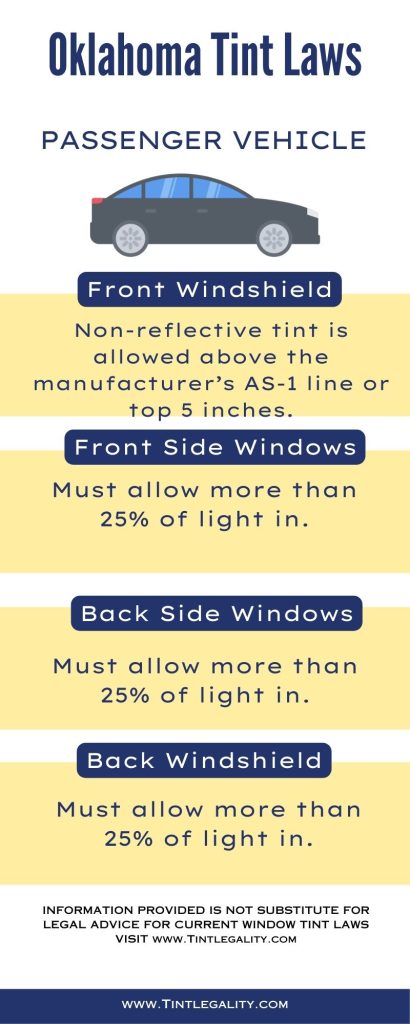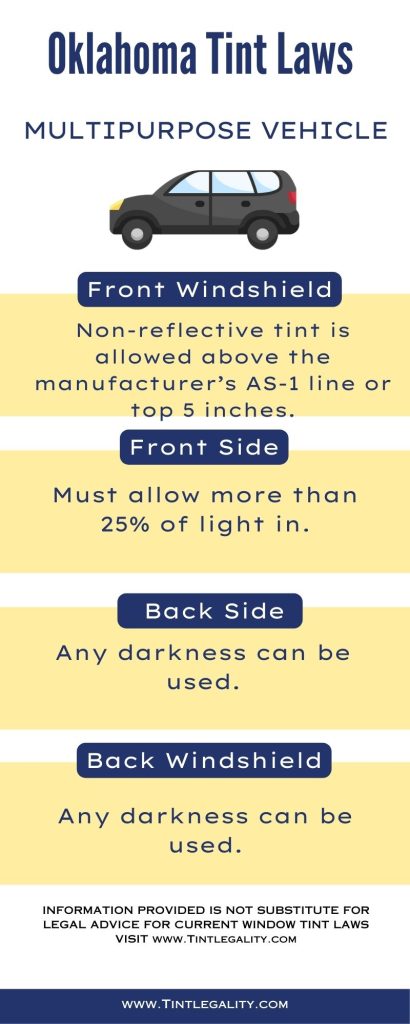In the world of car customization, one aspect that’s often overlooked yet critically important is adhering to your state’s tint laws.
Oklahoma tint laws were enacted in 2005, ensuring the safety of drivers on the road while allowing them a measure of personalization for their vehicles.
Let’s explore these laws in detail.
Regulations Regarding Window Tint in Oklahoma
In Oklahoma, the law has clear instructions about how dark or reflective the tint on different windows can be.
It’s crucial to follow these rules to avoid any legal hassles.
| Car Type | Window | Visibility Limit | Reflective Limit |
|---|---|---|---|
| Sedan | Front Side | 25% | 25% |
| Sedan | Back Side | 25% | 25% |
| Sedan | Rear | 25% | 25% |
| SUV/Van | Front Side | 25% | 25% |
| SUV/Van | Back Side | No limit | 25% |
| SUV/Van | Rear | No limit | 25% |
Windshield
As per Oklahoma tint laws, non-reflective tint is allowed along the top of the windshield, specifically above the manufacturer’s AS-1 line.
However, the tint must not exceed 5 inches from the top.
The goal here is to strike a balance between reducing glare and ensuring visibility.
Front Side Windows
The tint on the front side windows plays a vital role in driver visibility.
Oklahoma law permits up to 25% VLT (Visible Light Transmission) for these windows, meaning that they must allow at least 25% of light to pass through them.
Back Side Windows
Just like the front side windows, the back side windows must also allow a minimum of 25% light transmission.
The goal here, again, is to balance between privacy, aesthetics, and most importantly, safety.
Rear Window
For the rear window, the law is the same as the front and back side windows.
It should allow at least 25% of light to pass through, ensuring that drivers have a clear view of vehicles behind them.


Additional Regulations
Reflection
In terms of reflection, Oklahoma window tint laws stipulate that window tints must not be more than 25% reflective. This is to avoid blinding other drivers on the road with excessive glare.
Medical Exemptions
For those with specific medical conditions that necessitate darker window tints, Oklahoma law allows medical exemptions.
It’s advisable to consult with medical professionals and local authorities to understand the application process for this exemption.
Color Restrictions
Oklahoma tint law also bans color-altering tinting materials.
This means that tints with colors that could mislead other drivers or interfere with law enforcement duties are not permitted.
Side Mirrors
If the rear window is tinted, dual side mirrors are required.
This is to compensate for potentially reduced visibility due to the darker rear window.
Exceptions to Legal Limits
While the Oklahoma tint laws are generally strict, there are exceptions.
These are mainly for medical reasons, where individuals can be allowed to have darker tints than what is legally permitted.
Penalties for Breaking the Law
Non-compliance with the Oklahoma tint laws can lead to penalties.
The severity of these penalties usually depends on the number of offenses a driver has committed.
Fines
First Conviction
On the first conviction, drivers can expect to pay a fine of up to $500.
Second Conviction
For a second conviction, the fine increases, reaching up to $1000.
Third Conviction
For third and subsequent convictions, the fine can be as high as $2000.
Other Penalties
Beyond fines, other penalties for non-compliance include possible community service, probation, and in severe cases, even imprisonment.
It’s essential to note that these penalties are at the discretion of the court and may vary based on individual circumstances.
To avoid running afoul of the law, it’s always best to comply with the Oklahoma tint laws and maintain your car’s window tints within the stipulated limits.
Enjoy the ride, but stay on the right side of the law!
References:
https://en.wikipedia.org/wiki/Oklahoma